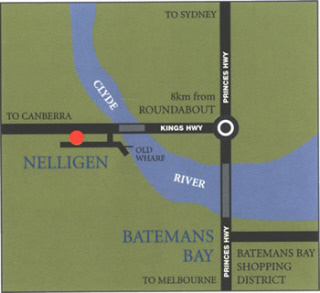 Nobody seems to know, not even my wife who usually knows everything! ☺
Nobody seems to know, not even my wife who usually knows everything! ☺
As Stuart Magee explains in his beautiful little volume of local history, The Rivers and the Sea, "the need for the place arose in the 1850s when Braidwood and its satellites such as Majors Creek, Araluen and Mongarlowe were up to their ears in the explosion of people and commerce surrounding the discovery of gold.
The movement of goods, people and information between Braidwood and Sydney was chancy and oh so slow. Depending on the weather, bullock trains might take three weeks or three months. Horse-drawn carriage or dray was usually quicker but limited in capacity and expensive. Down the mountain lay the very navigable Clyde and thence a 24-hour run by steamship to Sydney. There was, as I understand the historian Reynolds, some competition between Currowan and Nelligen as to which would receive Braidwood's blessing, and Nelligen won out.
So, in the 1850s, the town was laid out and the road from Braidwood was opened. And a tough road it was too. There is a number of old photos showing the grim results of teams of horses and bullocks going over the side of the Clyde Mountain road.
Nelligen boomed! Over the next 20 years there arose four pubs, two stores, a blacksmith, a bakery, a police station, a court-house, schools, churches and a post office, Above all was the terminal building of the Illawarra Steam Navigation Company. If today you were to set up your picnic in that nice little park between the general store and the wharf, you would be smack in the middle of the 126 x 45 feet ISNC's jetty and store (oh, very well then, 38 x 14 metres). Twice a week the steamers plied between Nelliugen and Sydney, stopping at the far less consequential village of Batemans Bay on the way. The size of some of the paddle-steamers, and later screw-steamers, is astonishing. The Kembla, a paddle-steamer in use on the Clyde from 1861, was 183 feet long. The S.S. Moruya was 150 feet and 530 tons. The S.S. Allowrie was 180 feet. It ran aground on a mudflat in the river on one occasion and had to await the high tide to float it off. The last steamer to call at the Port of Nelligen was in 1952 - 99 years after the first."
But the goldfields centering on Braidwood started to run down, then the timber industry went into decline, and, Stuart continues in his little book, "after such a pivotal role in the development of the southern parts of the state, Nelligen has been deserted even by the highway and left to fend for itself.
All up and down the coast the faces of small towns are being tarted up and titivated by tourist-boards and enthusiastic councils. But Nelligen remains untouched and unimpressed by such progress. Not even the modern marvels of reticulated water and sewerage have imposed themselves upon it.
If I lived there I would hope not to see it change. But you sense it may just be resting after its great exertions and sooner or later some bright spark will again see it as the right place to do heroic things." (reproduced with Stuart's permission)
There is so much more in this delightful book but I won't spoil your anticipation as I am sure your local Angus & Robertson has a copy of this enjoyable read!


